One of my highlights from Gen Con 2016 was Clank!, designed by Paul Dennen and published by Dire Wolf Studios and Renegade Games. It’s a mixture of deck-building, map exploration, and press-your-luck, and the end result is a lot of fun. Get in, grab an artifact, and get out—before the dragon catches you!
At a glance: Clank! is a deck-building game for 2 to 4 players, ages 13 and up, and takes 30–60 minutes to play. It retails for $60.00 and is available now online and in stores. I think younger kids who have some experience with deck-building games would be able to play just fine—my 10-year-old was able to keep up; there are monsters but everything has a colorful fantasy style (like the dragon on the cover) so nothing is too scary.

Components
Clank! is a deck-building game, so of course you get a bunch of cards, but it also has a slew of other things, because you run around on a board collecting treasures and money. Here’s what comes in the box:
- 1 double-sided game board
- 4 Meeples
- Tokens:
- 7 Artifacts
- 11 Major Secrets
- 18 Minor Secrets
- 2 Master Keys
- 2 Backpacks
- 3 Crowns
- 3 Monkey Idols
- 4 Mastery tokens
- Coins (1 and 5 denominations)
- 120 Clank! cubes (30 each in 4 colors)
- Dragon marker
- 24 Dragon cubes
- Dragon bag
- Reserve cards:
- 15 Mercenary
- 15 Explore
- 12 Secret Tome
- 1 Goblin
- Starting cards (4 decks, each including the following):
- 6 Burgle
- 2 Stumble
- 1 Sidestep
- 1 Scramble
- 100 Dungeon cards

The board is fun to look at, with all of those passages leading between the spaces. It’s double-sided, with a more advanced side on the back (with the red sky), and there are lots of spots everywhere for the artifacts, secret tokens, and so on. My only complaints: there isn’t a dedicated place to put the market tokens on the board, so I end up just squeezing them in somewhere. Also: although the spots for the secrets are all marked with little dotted circles and question marks, the dark color can make it hard to spot all of them sometimes.
There are a whole bunch of different tokens in the game, and they’re fairly easy to tell apart: the secret tokens all have a question mark on the backs, and are two different sizes. The coins are in between the two sizes and look clearly like coins. Artifacts are large rounded hexagons, and there are a couple of tokens that are square that don’t get mixed in with the rest. I’ll have more about each of these types of tokens later, in the How to Play section.

I like the fact that the four meeples are actually different from each other—each is holding a different weapon. I suppose that could also be a boon for color-blind players, though the weapons are fairly small (and the wooden cubes are all the same shape so you will still need somebody who can tell all of those apart).
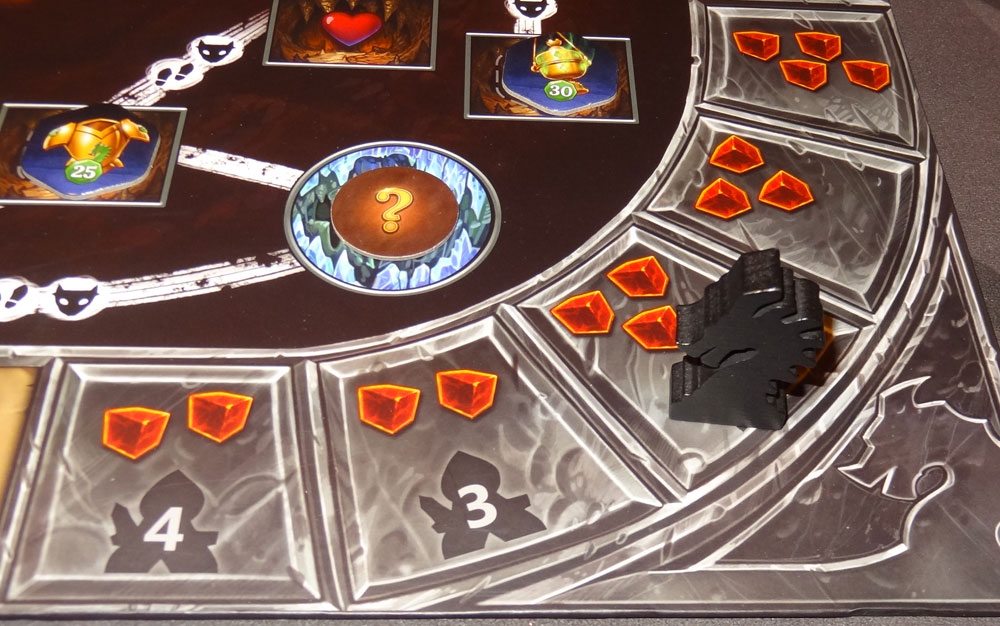
The dragon marker is a large wooden silhouette of a dragon head—pretty impressive. And the dragon bag is also really nice, thick fabric with an embroidered red dragon on one side.
The cards themselves are fine—not superb quality but pretty good. The artwork on them is fun, though, and it’s also fun to read the flavor text, which is included on every card.
How to Play
The goal of the game is to have the most points at the end of the game by accumulating treasures, money, and valuable cards—but in order to score, you must make it out of the depths alive, and you must have collected an artifact.
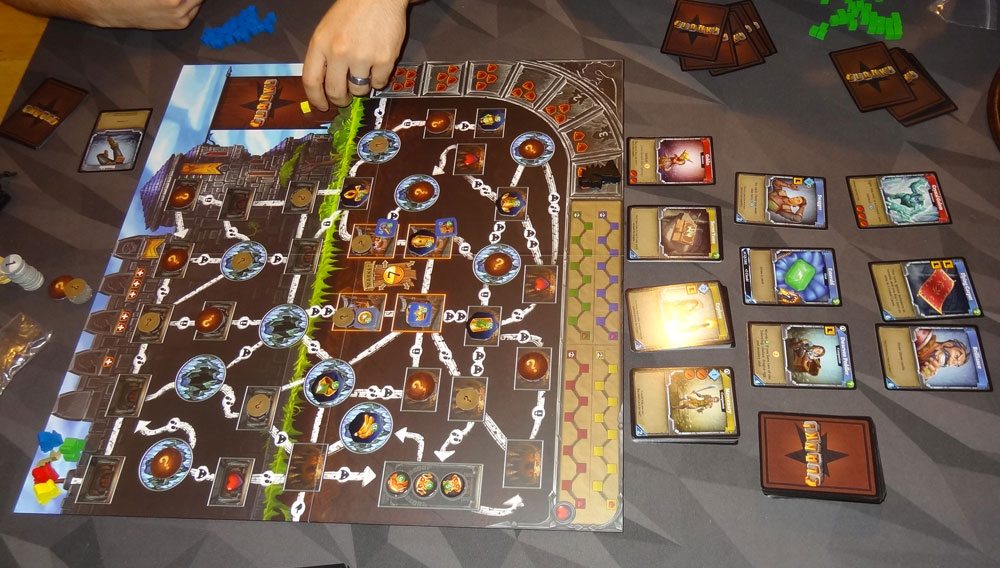
To set up, give each player a set of starting cards, 30 Clank! cubes, and a meeple, which is placed at the top left section of the board by the flag. Set up all of the tokens on the game board in their indicated spaces: artifacts, major and minor secrets (face-down and shuffled), and monkey idols. Note: if there are fewer than 4 players, you’ll remove 1 or two artifacts at random before placing them. Market items (keys, backpacks, and crowns) are placed on the market area, and Mastery tokens are placed near the flag at the top left. Coins are set aside. The Dragon marker is placed on the rage track at the bottom left, in the spot marked with the number of players, and the black dragon cubes are put into the bag.

Separate the Reserve cards into the four types and place them next to the board. Shuffle the 100 dungeon cards, and turn 6 of them face-up to form the dungeon row, replacing any that have the dragon attack symbol and shuffling those back into the deck.
The first player adds 3 cubes to the Clank! area (the big banner at the top right), the second player adds 2 cubes, and so forth.
Clank! is a deck-building game, so each player will have their own deck, hand, and discard pile. As you acquire cards, they are placed into your own discard pile, and if your deck ever runs out when you need to draw a card, you reshuffle your discard pile to form a new deck, thus adding the new cards to the mix.

On your turn, you must play all of your cards in any order, using effects as noted. You will also generate resources from your cards, represented by the icons shown at the top left of each card: skill (blue diamond), swords, and boots. Skill points are used to acquire new cards. Swords are used to kill monsters. Boots are used to move around on the board.
You may play cards, acquire cards, and take actions in any order that you wish, but you must use all of your cards before you end your turn. Any time you gain gold, you take gold coins from the supply.

Here are the various actions:
Acquire a card from the reserve or dungeon row, by paying the cost shown at the bottom right—place it into your discard pile. Some cards have effects that happen immediately when you acquire them.

Use a device from the dungeon row—devices are purple cards, and you pay the skill points, use the device’s effect, and then put it into the dungeon discard pile (not your own).
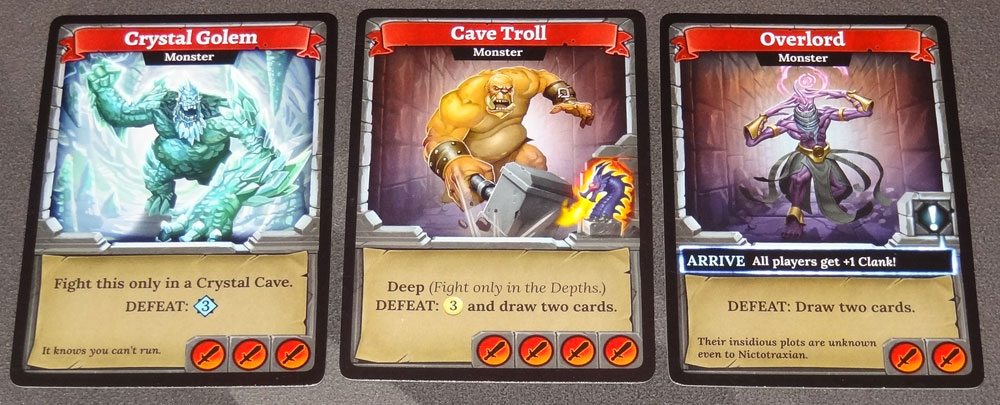
Fight a monster in the dungeon row (or the Goblin in the reserve) by paying enough sword points to match its cost. Gain the effect shown on the card, and then put the monster in the dungeon discard pile.
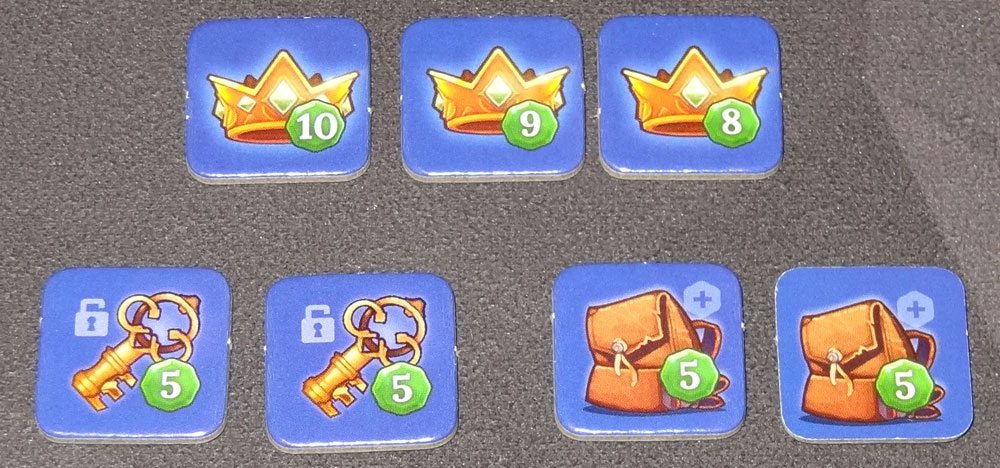
Buy from the market: if you’re in any one of the Market spaces, you may spend 7 gold coins to buy any of the items: Crowns are worth points; a backpack lets you carry an additional artifact; a key lets you travel through all locked passages. (Backpacks and keys are also worth points.)
Move by spending boots to move from one location to another. Paths with footprint icons require two boots to cross. Paths with monster icons require you to spend a sword or take a wound (by placing one of your cubes on your health track at the bottom of the board). Paths with locks are impassable unless you have a key from the market. Arrows are one-way paths. If you ever enter a Crystal Cave room, you may not use any more boots this turn to move. You may however, still use other abilities that may teleport you.
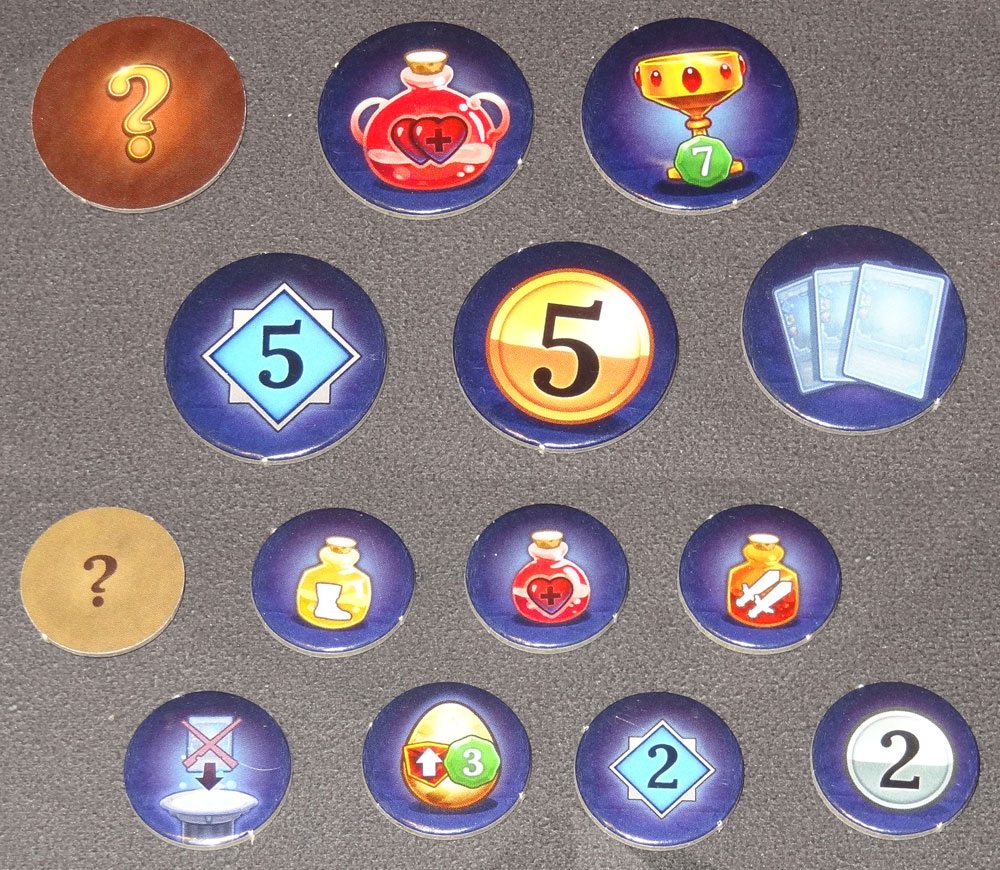
If you move into a room with a token, you may immediately take one token (not the market). Major and minor secrets are revealed immediately and used. You may only carry one artifact unless you have a backpack, and if you pick up an artifact or a dragon egg (one of the minor secrets) then you immediately move the dragon marker up one space on the rage track.
Clank! If you play any cards that say to add Clank!, you add that many of your cubes to the Clank! area on the board. Some cards will allow you to remove Clank!—you may use those to cancel out Clank! that you generate this turn, or to remove cubes from the Clank! area of the board, but you may not remove cubes from the bag.
At the end of your turn, after you have played all of your cards and used as many of your resources as you’d like, discard all of the cards in your play area and draw five new cards. Then, if you have removed any of the six cards in the dungeon row, replace them with cards from the deck. If any of the cards have a dragon attack symbol on them, you will trigger one dragon attack (even if multiple cards have the icon): put all of the cubes in the Clank! area into the bag, and then draw the number of cubes shown on the rage track. Some cards in the dungeon row can even increase the number of cubes you’ll need to draw. Black cubes are set aside, and colored cubes are placed on the matching health track.
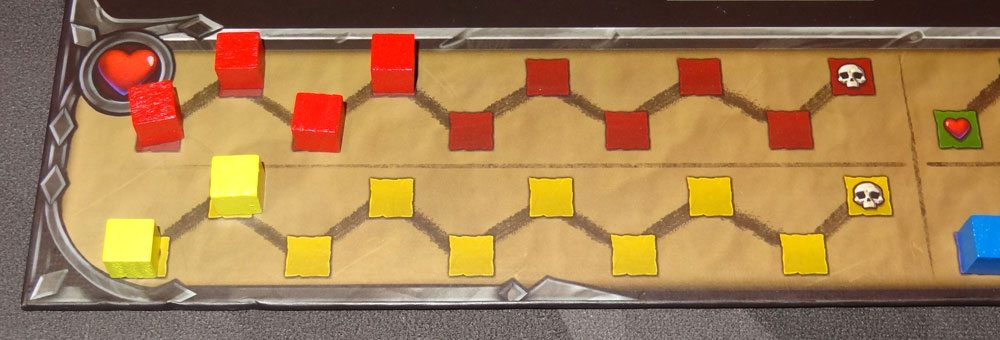
When your health track fills up with cubes, you’re knocked out: if you’re above ground and have an artifact, you get rescued by the townsfolk and still score points. If, however, you haven’t collected an artifact or you die in the depths (below ground level), then you won’t score anything at all. If you manage to get an artifact and make it all the way back to the entrance, you get a mastery token, worth 20 points. Either way, you are now out of the game, and your Clank! cubes drawn from the bag no longer affect you, and you don’t play any cards on your turn.
Finally, the first time a player is out of the game, they put their pawn on the countdown track at the top of the board. Each time it would be their turn, they move the pawn to the right, and trigger a dragon attack with additional cubes as marked on the countdown track—one, then two, then three. Finally, on the next turn, when the pawn moves to the skull space, the game ends—anyone who didn’t escape the depths is eliminated, and everyone else tallies up their scores.
Your score includes the little green value on artifacts, tokens, and at the top right corner of cards, plus the amount of gold you accumulated. Highest score wins, and ties go to the player with the most valuable artifact.
The Verdict
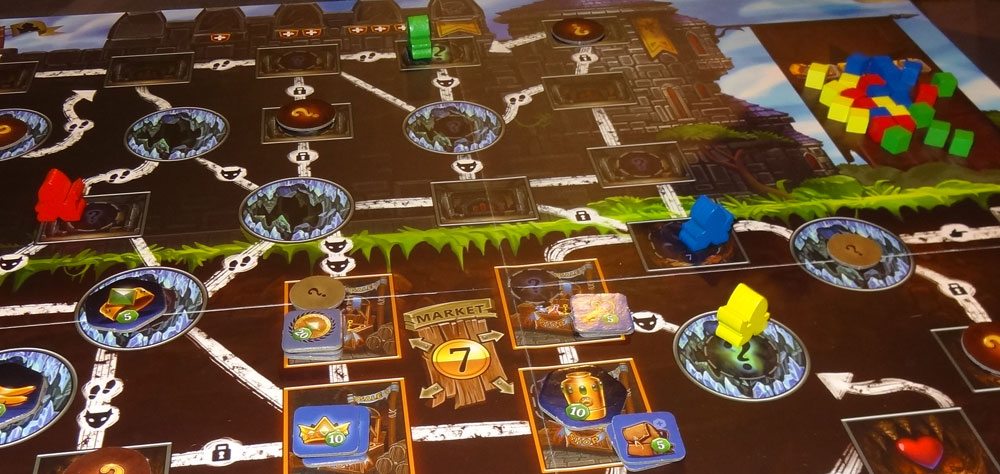
At Gen Con 2016, I played a demo of Clank! run by designer Paul Dennen, and had a lot of fun. I played against fellow GeekDad Gerry Tolbert and his wife Sara, who put the “Tattle” card to great use by making Gerry and me add a lot of Clank! cubes while she got away with the treasure. It was one of my highlights at Gen Con, so I’m excited to tell you about it now that it has been officially released.
I’ve always loved deck-building games, and I like the way it can be incorporated into games–in this case, combining the deck-building with moving around on the board means that you have to manage your deck to ensure that you have enough boots to get around, but also swords to get past the monsters. The randomized dungeon row means that you won’t see the same cards every time so you can’t just pick the same strategy every time you play, but you have to react to what’s available and what your opponents are doing.
The deck-building isn’t perfect, though: Clank! doesn’t have a lot of opportunities to weed your deck of the basic cards: the Master Burglar lets you remove basic Burgle cards, and there are a few other one-time-use effects that will let you remove cards from your deck (helpful for getting rid of that Stumble), but for the most part you’ll just be accumulating cards rather than removing any. However, there are some interesting cards that can let you get around weak cards: Sleight of Hand lets you discard a card (without playing it) to draw two more cards, and there are several other cards available that let you draw more cards so that weak cards don’t slow you down too much.
Because the dungeon row is a randomized mix of six cards, you can run into some of the same problems as in Ascension: maybe you’ve put a lot of swords in your deck to fight monsters, but barely any monsters show up, which means you spend most of them killing the basic Goblin for 1 coin. Or maybe you’ve gotten cards that are great for skill points, but the dungeon row is full of monsters, leaving nothing great to purchase. That’s simply based on luck-of-the-draw, which can really bother some players if they want to be able to plan more strategically.

The dungeon row does have another interesting effect, though: because dragon attacks are triggered primarily when you refill the dungeon row, it means that you can avoid a dragon attack at the end of your turn by purchasing or killing monsters only from the reserve (or none at all). The more cards you take out of the home row, the greater the chances that there may be an attack. That gives players a little bit of control—but not much!—over their fates.
Another issue is that there isn’t a built-in mechanic for refreshing the dungeon row if there’s nothing there that you want. I have, on occasion, had the dungeon row filled with cards that nobody really wanted to buy, and we considered adding a house rule that let you spend some number of skill points simply to refresh the row—but then you’d have to figure out what to do about dragon attacks revealed then.
I really do like the Clank! mechanic: it’s just fantastic and suspenseful—both when you’re drawing cards to refill the dungeon row, and as you pull out cubes when an attack happens. That’s particularly true as your health track starts filling up: you realize that a single dragon attack could kill you if enough of your color is pulled, and you breathe a sigh of relief when you see a black cube or somebody else’s color.
There’s a very good press-your-luck element in play, too. The most valuable artifacts are the hardest ones to get to: deeper in the depths, past locked passages or multiple monsters. The 30-point artifact is hidden in a dead-end behind a lock, so you’ll first have to get to the market, have enough coins to buy a key, and then get in and back out again.
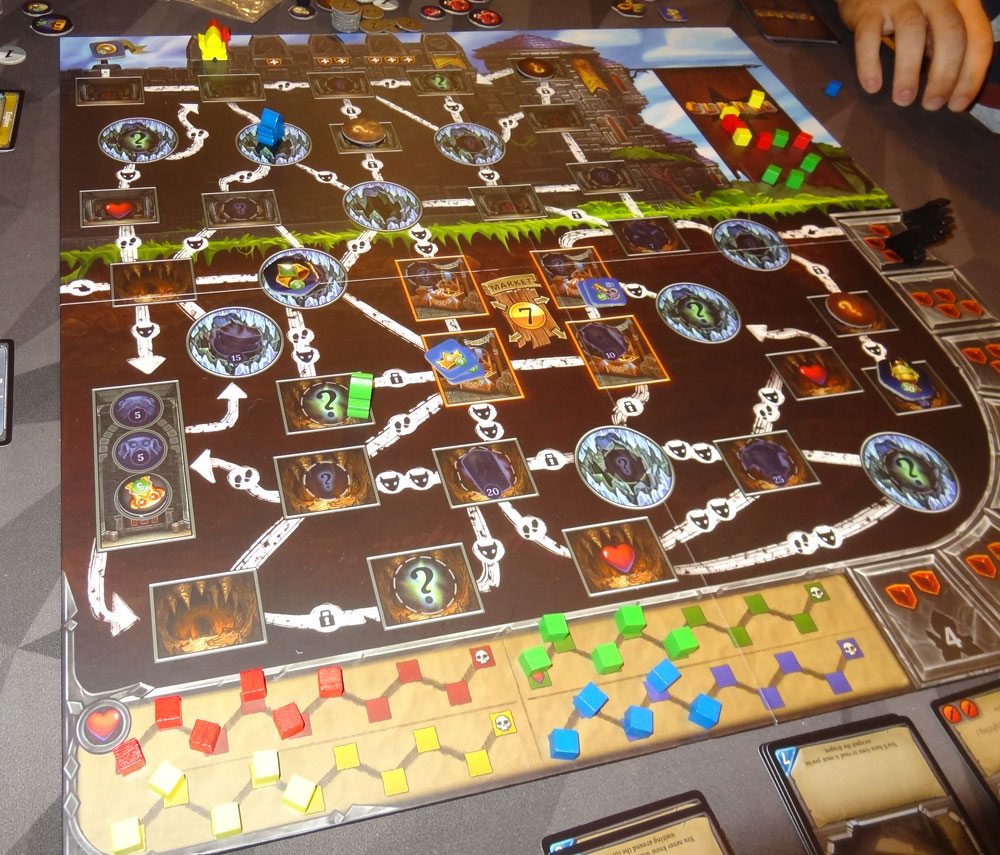
I’ve seen different strategies pay off: you can make a run for the smaller artifacts and get out quickly, grabbing a 20-point mastery token and then limiting the amount of time everyone else has. You can go for valuable cards (often making a lot more Clank!) and just try to get back out of the depths before the dragon strikes you down. You can try to minimize your Clank! so that you’ve got more time to get to a valuable artifact. You can buy a backpack in the market and take two easier-to-retrieve artifacts. There are various ways to approach the game, but you really have to watch what other players are doing to gauge how much time you have left to get out. I’ve played several games in which somebody died either one step away from getting out of the depths or one step away from exiting the castle (ouch!), so hastening everyone else’s demise can be crucial to victory.
It’s also nice that points come from various places: the artifacts and coins are there for everyone to see, but the value of the cards in your deck is less easy to calculate until the end. That means that (unless you’re very good at counting cards) nobody is really entirely sure who’s ahead. I’ve had a couple games with unexpected winners, and at least one where we had to go to the tie-breaker rule because it was so close.
I have a few quibbles: I’ve already mentioned some of the issues that can arise with the deck-building. The setup takes a little while simply because you’ve got to sort of several types of tokens and get them all in the right places, so you have the deck-building setup and a board setup. And I’ve mentioned in the Components section that I really wish they’d put an area on the board for the market tokens, because putting them in one of the four market rooms makes it look like you can only buy them there, but there’s no other good place to put them that doesn’t cover up either the 7-coin price or paths between rooms or something. I suppose once everyone is familiar with the game, you can just set them to the side of the board, but it does seem really strange that everything seems to have a spot but those.
That said, those really are my only complaints about the game, and they’re relatively minor. I’ve really enjoyed Clank! both with my kids and with adult gamers, and it’s definitely one of my favorites from this year. I haven’t yet tried the alternate map, but once my kids are a little more familiar with the game, I think we’ll be giving that a try, too.
Look for Clank! at your local game store, or order a copy from Amazon.
Review copy provided by Renegade Games.
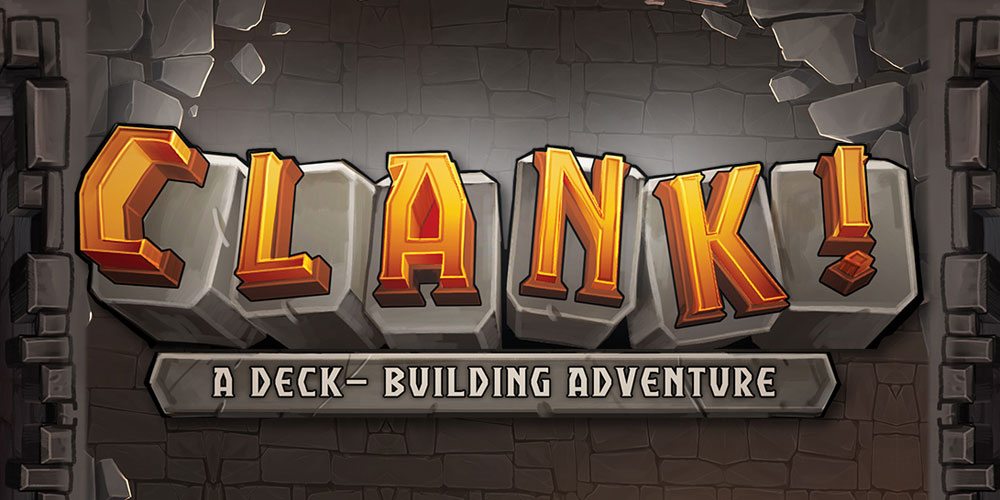




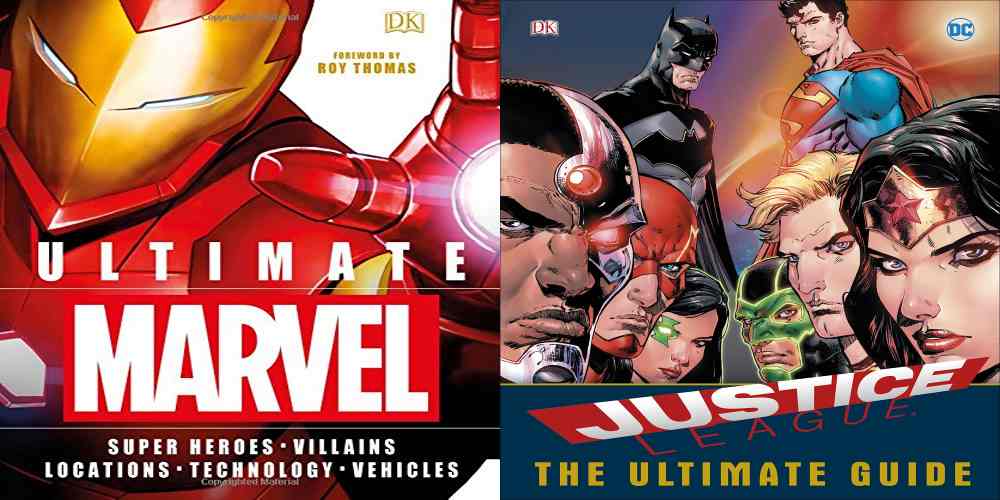

Hello Jonathan, great review thanks!!! I have bought and played Clank! – it is a really fun game. Because you played with the game designer, you may know the answer to my question. Do the purple device cards like Teleporter have to be used immediately or can buy them placing them in front of you to use later (e.g., like potions). The rules just say that when you buy them, they do NOT go into your deck, but they don’t actually say where they go or that you have to use them immediately. The rules then say after they are used they go in the Dungeon discard. So it’s clear they are one time use, but not clear if they must be used immediately on acquisition or can be held for later use.
Hi, Michael! The purple device cards must be used immediately when you pay for them—the rule says that you acquire them by paying skill, but then instead of putting it in your deck, you use the ability and then put it in the Dungeon discard pile. The use is tied to the purchase as an action—you can’t separate the two.
We always just put the market stuff on the space with the 7 that says market. In my opinion that is the dedicated spot. Just remember the stuff costs 7. That’s it.
On the back of the board, that’s almost required, since the market spaces are not near each other at all. But it’s strange to me that they didn’t have little squares for the market stuff, with a price visible when they’re there.
Great review! I only played this version once and enjoyed it. I then picked up the Clank! Legacy game and it was AMAZING! One of my family’s favorite games period, of any kind. It’s an excellent legacy game with constant fun surprises and an excellent story. I reviewed it here, if it’s of interest. https://alphastream.org/index.php/2020/04/30/a-legacy-game-with-a-superb-story-clank-legacy-acquisitions-incorporated/
Thanks, Teos! I’ve played the Legacy version as well, and we really enjoyed it, too—just haven’t had a chance to write it up myself yet. 🙂